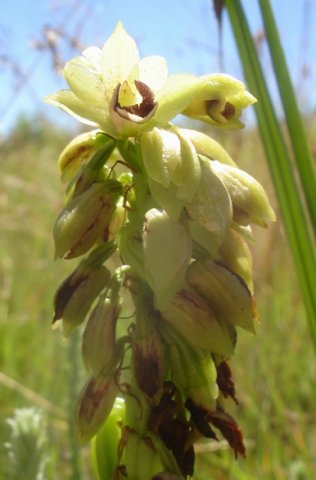Orthochilus

Author: Ivan Lätti
Photographer: Judd Kirkel Welwitch
Orthochilus is a genus of ground orchids, perennial plants that grow above-ground parts annually from rhizomes, tubers or corms. Some are dwarf plants, others over 1 m tall. The genus is related to and similar to Eulophia. The Orthochilus name was resurrected in 2014 when 34 Eulophia species were brought together to form the new genus.
Few leaves, somewhat grass-like, are grown annually in a separate shoot that may be present during flowering. The often long, sometimes lanceolate leaves may be longitudinally veined, sometimes well taller than the inflorescence.
The flowers usually grow in a congested spike, from a few to more than 30 flowers per inflorescence. The perianths of Orthochilus flowers are more bell-shaped than those of Eulophia, the petals often shorter than the sepals. The flowers are white, cream or yellow, sometimes pale greenish or lime-green with brown or purple parts. Unlike Eulophia, the Orthochilus species have petals and sepals that are fairly similar in shape, size and colour, only the lips differing markedly.
The lips are usually crested by papillae, the protuberances sometimes in rows and differently coloured to the rest of the flowers, sometimes lined or spotted. The generic name Orthochilus is derived from the Greek words orthos meaning straight or upright and cheilos meaning lip, referring to the straight or upright lips of the flowers, differentiating them from those of Eulophia. The spurs at the back of the lips are small, sometimes sac-like. Many local species flower in spring or summer. The fruits are capsules.
There are about 35 species of Orthochilus, found in Sub-Saharan Africa, Madagascar, tropical and subtropical America; 12 of them occurring in South Africa. Some species feature in horticulture, some in traditional medicine.
The plant in picture is Orthochilus foliosus (Leistner, (Ed.), 2000; Manning, 2009; Wikipedia; https://www.zimbabweflora.co.zw).

